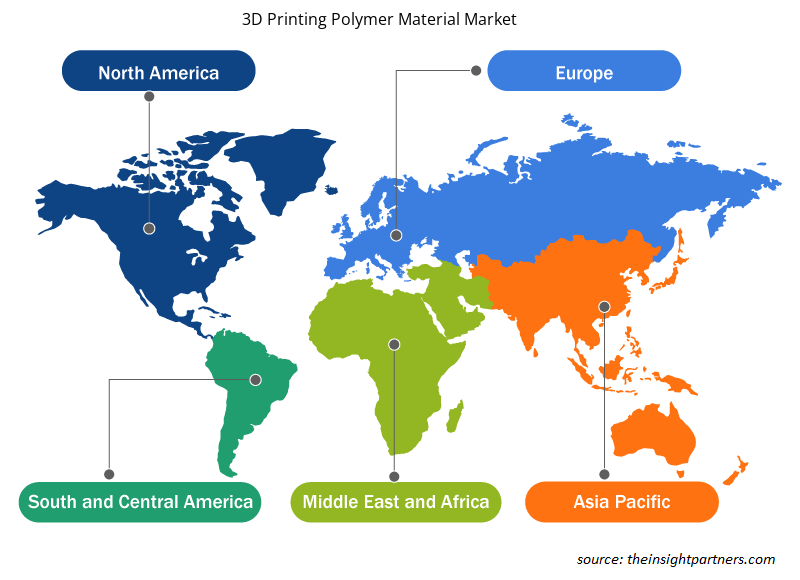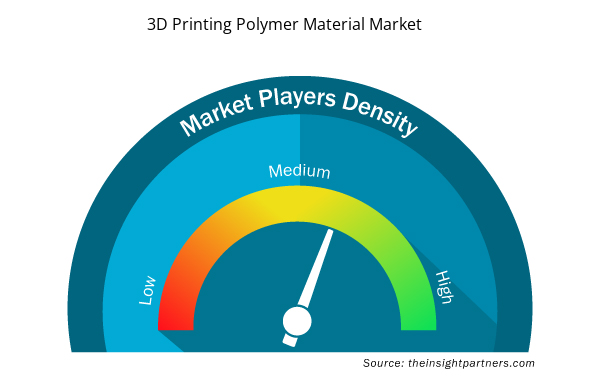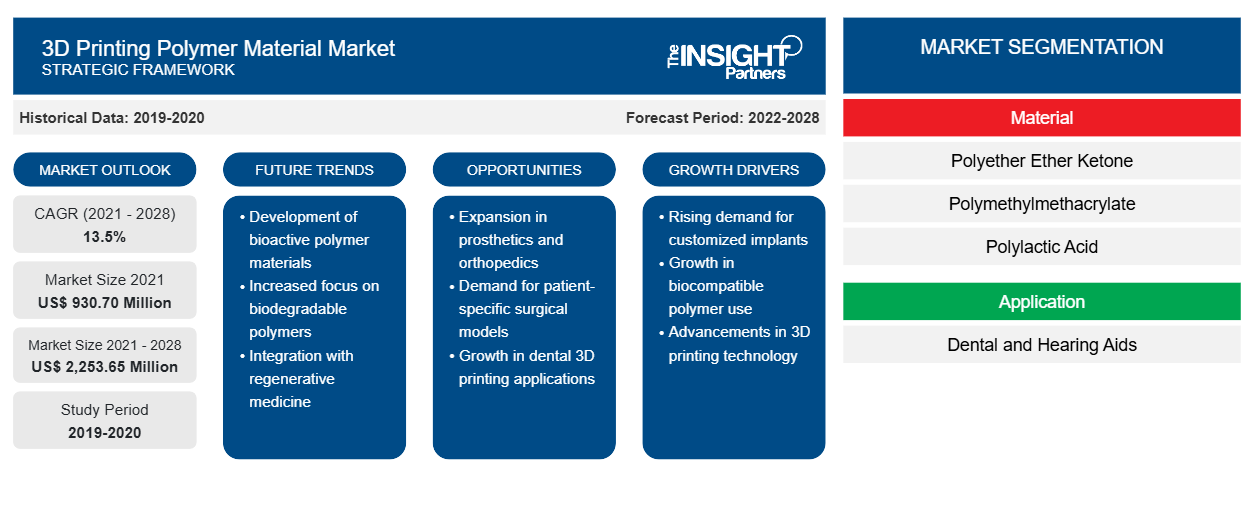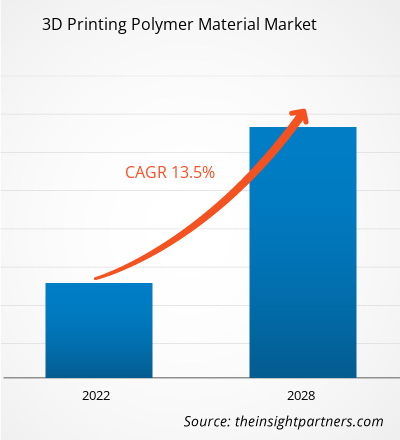医療用途の3Dプリントポリマー材料市場は、2021年に9億3,070万米ドルと評価され、2028年までに22億5,365万米ドルに達すると予測されており、2021年から2028年にかけて13.5%のCAGRで成長すると予想されています。
ポリマーは主要な3Dプリント材料の1つです。ポリマー3Dプリントは、特に医療分野での産業での用途が広がっている新興技術です。3Dプリントポリマー材料は、ポリエーテルエーテルケトン、ポリメチルメタクリレート、ポリ乳酸で構成されています。3Dプリントポリマー材料市場の成長の主な原動力の1つは、さまざまな用途での歯科での3Dプリントの使用の増加です。歯科では、3Dプリントの使用が急速に増加しています。3Dプリント技術は、歯科医が損傷した歯の交換や修復、歯列矯正モデルの作成、クラウン、キャップ、義歯の製造に多用されています。
2020年、北米は医療用途の世界的な3Dプリントポリマー材料市場で最大の収益シェアを占めました。北米では急速な都市化と工業化により高齢化が進み、騒音にさらされる機会が増えているため、聴覚障害者が増加しています。これにより補聴器の需要が高まり、医療用途の北米 3D プリント ポリマー材料市場の成長が促進されます。所得およびプログラム参加調査 (SIPP) によると、米国では 60 万人以上が聴覚障害者であり、国内人口の約 2,800 万人が部分的な聴覚障害を患っています。そのため、この地域では補聴器の需要が高まっており、3D ポリマー材料メーカーにとって北米での市場シェアを拡大する有利な機会が生まれています。
要件に合わせてレポートをカスタマイズする
このレポートの一部、国レベルの分析、Excelデータパックなど、あらゆるレポートを無料でカスタマイズできます。また、スタートアップや大学向けのお得なオファーや割引もご利用いただけます。
- このレポートの主要な市場動向を入手してください。この無料サンプルには、市場動向から見積もりや予測に至るまでのデータ分析が含まれます。
COVID-19パンデミックが医療用途向け3Dプリントポリマー材料市場に与える影響
COVID-19パンデミック以前は、さまざまな医療機器、器具、カスタマイズされたインプラント、医療モデルを作成するための3Dプリントにおけるポリマーの需要が高かったため、医療用途の3Dプリントポリマー材料市場は成長していました。しかし、2020年には、国境や国境の閉鎖によって引き起こされたバリューチェーンの混乱により、さまざまな業界が事業を減速せざるを得ませんでした。COVID-19パンデミックは、ロックダウン、渡航禁止、事業停止により、さまざまな国の経済や産業に悪影響を及ぼしました。歯科インプラント、歯科補綴物、インプラントアクセサリー、補聴器などの用途における3Dプリントポリマー材料の需要は、これらの製品の需要が低いため減少しました。しかし、COVID-19パンデミックの間、さまざまな個人用保護具や医療機器の製造のために3Dプリントポリマーの需要が増加しました。
ポリマー3Dプリントは、パンデミック中に人工呼吸器バルブ、安全ゴーグル、防護フェイスシールド、検査用綿棒を製造するための実行可能な技術としての地位を確立しました。
市場洞察
歯科における 3D プリントの利用増加
歯科では、3D プリントの使用が急速に増加しています。3D プリントは、サブトラクティブ/ミリング技術に比べてさまざまな利点があります。複雑な形状を簡単に作成でき、ミリングで失われることが多い材料の無駄を削減できます。3D プリントでは、複数の器具を一度に印刷できます。3D プリントでは精度も向上します。歯科における 3D プリント技術の用途は多岐にわたります。
口腔疾患は、世界中のさまざまな国で大きな健康上の負担となっており、生涯にわたって人々に影響を与えています。2017 年の世界疾病負担によると、永久歯の未治療の虫歯が最も一般的な健康状態です。都市化の進行と生活条件の変化に伴い、口腔疾患の有病率は増加し続けています。3D プリント技術を使用して製造されたさまざまな歯科製品は、歯の構造の修復に幅広く使用されています。したがって、虫歯やその他の歯科疾患の発生率が高いため、歯科では 3D プリント製品の使用が増加しています。
アプリケーションインサイト
用途別に見ると、医療用3Dプリントポリマー材料の世界市場は、歯科用と補聴器用に分類されます。2020年の医療用3Dプリントポリマー材料市場では、歯科用セグメントが大きなシェアを占めました。このセグメントの医療用3Dプリントポリマー材料市場の成長は、金属やセラミックに比べて生物学的特性と機械的特性が向上し、処理が容易で、生産コストが低く、軽量であるため、足場構造の設計にポリマー材料が広く採用されたことに起因しています。
Evonik Industries AG、STRATASYS LTD、Formlabs、Henkel AG & COMPANY、KGAA、Arkema、BASF SE、Roboze、Bionic Production GmbH、Orion Additive Manufacturing GmbH、Solvay SA は、医療用途の世界的な 3D 印刷ポリマー材料市場で活動している企業の一部です。市場プレーヤーは、顧客の需要を満たす高品質の製品の提供に重点を置いています。
3D プリントポリマー材料市場の地域別洞察
予測期間を通じて 3D 印刷ポリマー材料市場に影響を与える地域的な傾向と要因は、Insight Partners のアナリストによって徹底的に説明されています。このセクションでは、北米、ヨーロッパ、アジア太平洋、中東およびアフリカ、南米および中米にわたる 3D 印刷ポリマー材料市場のセグメントと地理についても説明します。

- 3Dプリントポリマー材料市場の地域別データを入手
3Dプリントポリマー材料市場レポートの範囲
| レポート属性 | 詳細 |
|---|---|
| 2021年の市場規模 | 9億3,070万米ドル |
| 2028年までの市場規模 | 22億5,365万米ドル |
| 世界のCAGR(2021年~2028年) | 13.5% |
| 履歴データ | 2019-2020 |
| 予測期間 | 2022-2028 |
| 対象セグメント | 素材別
|
| 対象地域と国 | 北米
|
| 市場リーダーと主要企業プロフィール |
|
3D プリントポリマー材料市場のプレーヤーの密度: ビジネスダイナミクスへの影響を理解する
3D 印刷ポリマー材料市場は、消費者の嗜好の変化、技術の進歩、製品の利点に対する認識の高まりなどの要因により、エンドユーザーの需要が高まり、急速に成長しています。需要が高まるにつれて、企業は提供を拡大し、消費者のニーズを満たすために革新し、新たなトレンドを活用し、市場の成長をさらに促進しています。
市場プレーヤー密度とは、特定の市場または業界内で活動している企業または会社の分布を指します。これは、特定の市場スペースに、その市場規模または総市場価値に対してどれだけの競合相手 (市場プレーヤー) が存在するかを示します。
3D プリントポリマー材料市場で事業を展開している主要企業は次のとおりです。
- エボニック インダストリーズ AG
- ストラタシス株式会社
- フォームラボ
- ヘンケルAG&カンパニー、KGAA
- アルケマ
免責事項:上記の企業は、特定の順序でランク付けされていません。

- 3Dプリントポリマー材料市場のトップキープレーヤーの概要を入手
レポートの注目点
- 医療用途向け3Dプリントポリマー材料市場における進歩的な業界動向は、プレーヤーが効果的な長期戦略を策定するのに役立ちます。
- 先進国市場と発展途上国市場で採用されているビジネス成長戦略
- 2019年から2028年までの医療用途向け3Dプリントポリマー材料市場の定量分析
- 3Dプリント用ポリマー材料の世界需要の予測
- 業界で活動するバイヤーとサプライヤーの有効性を示すポーターの5つの力の分析
- 競争市場の状況を理解するための最近の動向
- 医療用途向け3Dプリントポリマー材料市場の成長を牽引・抑制する要因と市場動向、展望
- 商業的利益の基盤となる市場戦略を強調し、市場の成長につながる意思決定プロセスを支援する
- 医療用途向け3Dプリントポリマー材料市場の規模は、さまざまなノードで異なります。
- 市場の詳細な概要とセグメンテーション、および3Dプリントポリマー材料業界の動向
- 有望な成長機会があるさまざまな地域における医療用途向け3Dプリントポリマー材料市場の規模
医療用途向け3Dプリントポリマー材料市場
材料
- ポリエーテルエーテルケトン
- ポリメチルメタクリレート
- ポリ乳酸
- その他
応用
- 歯科
- 歯科インプラント
- 歯科補綴
- インプラントアクセサリー
- その他
- 補聴器
企業プロフィール
- エボニック インダストリーズ AG
- ストラタシス株式会社
- フォームラボ
- ヘンケルAG&カンパニー、KGAA
- アルケマ
- BASF SE
- ロボゼ
- バイオニックプロダクション株式会社
- オリオン・アディティブ・マニュファクチャリング社
- ソルベイSA
- 過去2年間の分析、基準年、CAGRによる予測(7年間)
- PEST分析とSWOT分析
- 市場規模価値/数量 - 世界、地域、国
- 業界と競争環境
- Excel データセット


- Trade Promotion Management Software Market
- Long Read Sequencing Market
- Sleep Apnea Diagnostics Market
- Hydrocephalus Shunts Market
- Vessel Monitoring System Market
- Fishing Equipment Market
- Small Internal Combustion Engine Market
- Cling Films Market
- Quantitative Structure-Activity Relationship (QSAR) Market
- Unit Heater Market

Report Coverage
Revenue forecast, Company Analysis, Industry landscape, Growth factors, and Trends

Segment Covered
This text is related
to segments covered.

Regional Scope
North America, Europe, Asia Pacific, Middle East & Africa, South & Central America

Country Scope
This text is related
to country scope.
よくある質問
Growing use of 3D Printing in Dentistry is one of the major driving factors for the market. 3D printing technology is becoming a staple technology in the field of dentistry. For dental sciences, 3D printing is an ideal technology due to the accuracy and customization incorporated into products made by 3D printing. 3D printing offers various advantages over the subtractive/milling techniques. It allows the production of complex geometries with ease and reduce wastage of material which is generally lost to milling. 3D printing technology offers a lucrative advantage in terms of reduced labor and time consumption.
Asia Pacific (APAC) is anticipated to grow with the fastest CAGR at rate of 14.0% from 2021 to 2028. Asia Pacific is one of the largest end-users of 3D dental structures across the globe. The increased demand for 3D dental structures in the region can be attributed to the rise in oral diseases in all age groups. As per the Government of India, 85% to 90% of adults have dental cavities, along with about 60 to 80% of children.
Due to the COVID-19 pandemic, butyric acid manufacturers witnessed a slight disruption in the supply chain of 3D printing polymer materials market for medical application during the first two quarters of 2020. However, the supply chain of polymer materials has been restored, and production activities have regained normalcy in late 2020. Later, the market was not significantly negatively impacted by the pandemic. Further, with the growing COVID-19 vaccinations and eased in lockdown restrictions, the global economy is resuming, and subsequently, the 3D printing polymer material market for medical application is regaining its growth.
Based on application, the dental segment accounted the largest share of the global 3D printing polymer material market for medical application. The segment's growth can be attributed to the high uptake of polymer materials for designing scaffolds structures due to their improved biological and mechanical properties, ease in processing, low production cost, and lightweight properties than metals and ceramics.
The major players operating in the global 3D printing polymer material market for medical application are Evonik Industries AG; STRATASYS LTD; Formlabs; Henkel AG & COMPANY, KGAA; Arkema; BASF SE; Roboze; Bionic Production GmbH; Orion Additive Manufacturing GmbH; and Solvay S.A.
During the forecast period, North America is anticipated to account for the largest share in the global 3D printing polymer material market for medical application. The 3D printing polymer materials market is flourishing in North America owing to high demand of hearing aid devices due to high deaf population along with its wide applications in the medical field.
Trends and growth analysis reports related to Chemicals and Materials : READ MORE..
The List of Companies - 3D Printing Polymer Material Market for Medical Application
- Evonik Industries AG
- STRATASYS LTD
- Formlabs
- Henkel AG & COMPANY, KGAA
- Arkema
- BASF SE
- Roboze
- Bionic Production GmbH
- Orion Additive Manufacturing GmbH
- Solvay S.A
The Insight Partners performs research in 4 major stages: Data Collection & Secondary Research, Primary Research, Data Analysis and Data Triangulation & Final Review.
- Data Collection and Secondary Research:
As a market research and consulting firm operating from a decade, we have published and advised several client across the globe. First step for any study will start with an assessment of currently available data and insights from existing reports. Further, historical and current market information is collected from Investor Presentations, Annual Reports, SEC Filings, etc., and other information related to company’s performance and market positioning are gathered from Paid Databases (Factiva, Hoovers, and Reuters) and various other publications available in public domain.
Several associations trade associates, technical forums, institutes, societies and organization are accessed to gain technical as well as market related insights through their publications such as research papers, blogs and press releases related to the studies are referred to get cues about the market. Further, white papers, journals, magazines, and other news articles published in last 3 years are scrutinized and analyzed to understand the current market trends.
- Primary Research:
The primarily interview analysis comprise of data obtained from industry participants interview and answers to survey questions gathered by in-house primary team.
For primary research, interviews are conducted with industry experts/CEOs/Marketing Managers/VPs/Subject Matter Experts from both demand and supply side to get a 360-degree view of the market. The primary team conducts several interviews based on the complexity of the markets to understand the various market trends and dynamics which makes research more credible and precise.
A typical research interview fulfils the following functions:
- Provides first-hand information on the market size, market trends, growth trends, competitive landscape, and outlook
- Validates and strengthens in-house secondary research findings
- Develops the analysis team’s expertise and market understanding
Primary research involves email interactions and telephone interviews for each market, category, segment, and sub-segment across geographies. The participants who typically take part in such a process include, but are not limited to:
- Industry participants: VPs, business development managers, market intelligence managers and national sales managers
- Outside experts: Valuation experts, research analysts and key opinion leaders specializing in the electronics and semiconductor industry.
Below is the breakup of our primary respondents by company, designation, and region:

Once we receive the confirmation from primary research sources or primary respondents, we finalize the base year market estimation and forecast the data as per the macroeconomic and microeconomic factors assessed during data collection.
- Data Analysis:
Once data is validated through both secondary as well as primary respondents, we finalize the market estimations by hypothesis formulation and factor analysis at regional and country level.
- Macro-Economic Factor Analysis:
We analyse macroeconomic indicators such the gross domestic product (GDP), increase in the demand for goods and services across industries, technological advancement, regional economic growth, governmental policies, the influence of COVID-19, PEST analysis, and other aspects. This analysis aids in setting benchmarks for various nations/regions and approximating market splits. Additionally, the general trend of the aforementioned components aid in determining the market's development possibilities.
- Country Level Data:
Various factors that are especially aligned to the country are taken into account to determine the market size for a certain area and country, including the presence of vendors, such as headquarters and offices, the country's GDP, demand patterns, and industry growth. To comprehend the market dynamics for the nation, a number of growth variables, inhibitors, application areas, and current market trends are researched. The aforementioned elements aid in determining the country's overall market's growth potential.
- Company Profile:
The “Table of Contents” is formulated by listing and analyzing more than 25 - 30 companies operating in the market ecosystem across geographies. However, we profile only 10 companies as a standard practice in our syndicate reports. These 10 companies comprise leading, emerging, and regional players. Nonetheless, our analysis is not restricted to the 10 listed companies, we also analyze other companies present in the market to develop a holistic view and understand the prevailing trends. The “Company Profiles” section in the report covers key facts, business description, products & services, financial information, SWOT analysis, and key developments. The financial information presented is extracted from the annual reports and official documents of the publicly listed companies. Upon collecting the information for the sections of respective companies, we verify them via various primary sources and then compile the data in respective company profiles. The company level information helps us in deriving the base number as well as in forecasting the market size.
- Developing Base Number:
Aggregation of sales statistics (2020-2022) and macro-economic factor, and other secondary and primary research insights are utilized to arrive at base number and related market shares for 2022. The data gaps are identified in this step and relevant market data is analyzed, collected from paid primary interviews or databases. On finalizing the base year market size, forecasts are developed on the basis of macro-economic, industry and market growth factors and company level analysis.
- Data Triangulation and Final Review:
The market findings and base year market size calculations are validated from supply as well as demand side. Demand side validations are based on macro-economic factor analysis and benchmarks for respective regions and countries. In case of supply side validations, revenues of major companies are estimated (in case not available) based on industry benchmark, approximate number of employees, product portfolio, and primary interviews revenues are gathered. Further revenue from target product/service segment is assessed to avoid overshooting of market statistics. In case of heavy deviations between supply and demand side values, all thes steps are repeated to achieve synchronization.
We follow an iterative model, wherein we share our research findings with Subject Matter Experts (SME’s) and Key Opinion Leaders (KOLs) until consensus view of the market is not formulated – this model negates any drastic deviation in the opinions of experts. Only validated and universally acceptable research findings are quoted in our reports.
We have important check points that we use to validate our research findings – which we call – data triangulation, where we validate the information, we generate from secondary sources with primary interviews and then we re-validate with our internal data bases and Subject matter experts. This comprehensive model enables us to deliver high quality, reliable data in shortest possible time.


 このレポートの無料サンプルを入手する
このレポートの無料サンプルを入手する